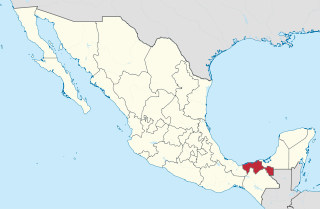
Tabasco, officially the Free and Sovereign State of Tabasco, is one of the 32 Federal Entities of Mexico. It is divided into 17 municipalities and its capital city is Villahermosa.
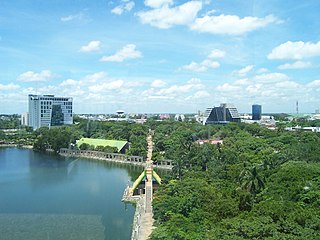
Villahermosa is the capital and largest city of the Mexican state of Tabasco, and the municipal seat of the Centro municipality. Villahermosa, the locality, reported a population of 353,577 in the 2010 census, whereas its Centro municipality had 640,359 inhabitants, a modest increase from the previous censuses. The municipality covers an area of 1,612 km2, while the city (locality) covers 63.2 km2 as of 2010. The city is situated 863 kilometres (536 mi) southeast from Mexico City.

Comalcalco is a city located in Comalcalco Municipality about 45 miles (60 km) northwest of Villahermosa in the Mexican state of Tabasco. Near the city is the Pre-Columbian Maya archaeological site of Comalcalco. The literal English translation of "Comalcalco" is "In the house of the comals". A comal is a pan used to prepare food.
Andrés Rafael Granier Melo is a Mexican politician affiliated with the Institutional Revolutionary Party PRI who in 2006 successfully ran for Governor of Tabasco. He is married to Teresa Calles Santillan and they have twin daughters Mariana and Paulina Granier Calles, and a son, Fabian Granier Calles.

The 2007 Tabasco flood occurred in late October and early November 2007 in the Mexican states of Tabasco and Chiapas, in which as much as 80% of the former was left under water. At least 20,000 people were forced to seek emergency shelter. Over 1,000,000 residents were affected.
XHCPBS-FM, known as La Voz de los Chontales, is an indigenous community radio station on 98.7 FM broadcasting in Spanish, Chontal Maya (yokot'an), Ch'ol and Ayapa Zoque from Nacajuca in the Mexican state of Tabasco. The station will form part of the Indigenous Cultural Broadcasting System (SRCI), part of the National Institute of Indigenous Peoples (INPI).
Manuel Sánchez Mármol was a Mexican writer, journalist, lawyer, politician, and a member of the Mexican Academy of Language.

Spanish Mexicans are citizens or residents of Mexico who identify as Spanish as a result of nationality or recent ancestry. Spanish immigration to Mexico began in the early 1500s and spans to the present day. The vast majority of Mexicans have at least partial Spanish ancestry and Mexicans of full or predominant Spanish ancestry make up close to half of the population. There are three recognized large-scale Spanish immigration waves to the territory which is now Mexico: the first arrived during the colonial period, the second during the Porfiriato, the third after the Spanish Civil War and the fourth after the financial crisis of 2007–2008.
María del Rosario Gutiérrez Eskildsen was a Mexican lexicographer, linguist, educator, and poet who is remembered for her studies on the regional peculiarities of speech in her home state of Tabasco as well as for her pioneering work as a teacher and pedagogue in Tabasco and throughout Mexico. She has at times been described as Tabasco's first woman "professionist".
Manuel Bartlett Bautista was a Mexican journalist, lawyer, judge, and politician who served as Governor of the State of Tabasco for two years, before being pressured to resign.
Francisco Javier Santamaría was an influential Mexican writer and politician who is best remembered for his contributions to the study of Mexican literature and lexicography; he variously worked or published as a bibliographer, essayist, geographer, journalist, judge, lawyer, lexicographer, linguist, naturalist, pedagogue, philologist, and poet. He also served as a Senator of the Republic and as Governor of the State of Tabasco.
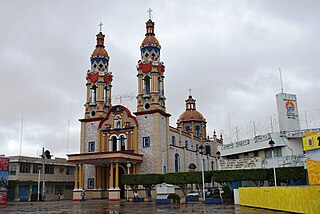
Paraíso is a town and municipality located in the north of the Mexican state of Tabasco, about 75 km due north of the state capital of Villahermosa on the Gulf of Mexico. Much of the area is traditionally dedicated to fishing and agriculture. Today, it is also an oil-producing area with the mostly oil-dedicated port of [[Dos Bocas, Tabasco|lt=Dos Bocas|es|Dos Bocas}}. There is also some tourism connected to the area's beaches and natural attractions, and the area is promoted under the state's Cacao Route tourism program.

Jalpa de Méndez is a city in Jalpa de Méndez Municipality located in the north of the state of Tabasco, Mexico. It is considered part of the Chontal Maya region of the state, known for its production of decorated dried gourds traditionally used for drinking chocolate and cured meats. Although there is some oil production and tourism, its main economic activity is agriculture, producing cacao, coconut and livestock.
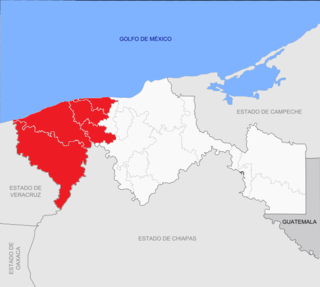
Chontalpa is an area in the Mexican state of Tabasco, which consists of four municipalities in the northwest of the state. Although the name refers to the state's Chontal Maya population, modern Chontalpa is a subregion of the Grijalva Region, and formed with economic concerns in mind. A large percentage of the state's Chontal Maya population does live here, with the municipality of Nacajuca having the largest concentration of indigenous, with the next largest concentration found just east of the region in the Villahermosa area. The subregion's economy is based on agriculture, especially livestock production as well as oil drilling, which have been at odds with each other because of severe degradation of the environment since the mid 20th century. Chontalpa is also home to Tabasco's two main archeological sites, La Venta and Comalcalco, along with numerous smaller sites.

Rodolfo Rincón Taracena was a Mexican journalist and crime reporter for Tabasco Hoy, a newspaper based in Villahermosa, Tabasco in southeastern Mexico. He was known for his direct reporting style, and wrote extensively about local drug trafficking and the growing presence of organized crime in his home state.
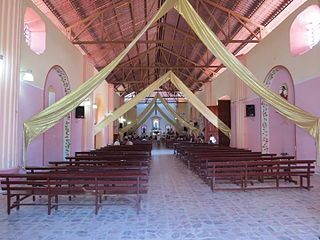
Tacotalpa is a small town in the southern Mexican state of Tabasco, the seat of the municipality of the same name. The city is located about 100 miles south of the coast of the Gulf of Mexico, and about 50 kilometers from the state capital Villahermosa, near the border with the state of Chiapas. Tacotalpa is located near the Usumacinta River. In 2010, the population of the town consisted of 8,071 inhabitants.
The following is a timeline of the history of the city of Campeche, Mexico.
The following is a timeline of the history of the city of Almería, Spain.











